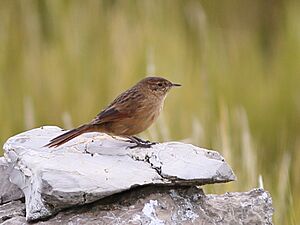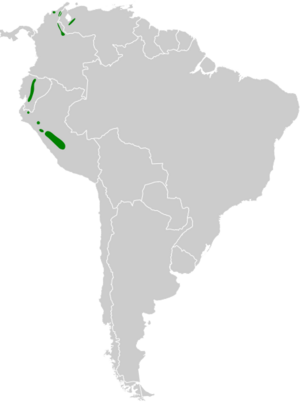Streak-backed canastero facts for kids
Quick facts for kids Streak-backed canastero |
|
|---|---|
 |
|
| Conservation status | |
| Scientific classification | |
| Genus: |
Asthenes
|
| Species: |
wyatti
|
| Subspecies | |
|
See text |
|
 |
|
| Range of streak-backed canastero sensu stricto as defined by the Clements taxonomy, but excluding A. w. graminicola. (See the Taxonomy and Distribution sections.) | |
| Synonyms | |
|
Asthenes sclateri (in part) |
|
The streak-backed canastero (Asthenes wyatti) is a type of bird found in South America. It lives in countries like Argentina, Bolivia, Colombia, Ecuador, Peru, and Venezuela. This bird belongs to the ovenbird family called Furnariidae.
Contents
About the Streak-backed Canastero
Scientists who study birds sometimes have different ideas about how to group them. For the streak-backed canastero, some experts think there are 12 different types, called subspecies. Other experts group them a bit differently. This means that some birds that look very similar might be considered separate species by some scientists, but just different types of the same species by others.
One example is the "puna canastero." Some scientists see it as a separate species, while others consider it a subspecies of the streak-backed canastero. This shows how bird classification can be a bit like a puzzle that scientists are still working on!
What Does It Look Like?
The streak-backed canastero is a medium-sized bird, about 16 to 18 centimeters (6 to 7 inches) long. It weighs between 17 and 25 grams (0.6 to 0.9 ounces), which is about the weight of a few quarters. Both male and female birds look alike.
The main type of streak-backed canastero, called A. w. wyatti, has a light brown and blackish face with a thin, pale stripe above its eye. Its head, neck, and back are olive-brown. You can see dark brown spots on its forehead and thin streaks on its head and neck. These streaks become wider on its back.
Its wings are dark with reddish-brown edges, especially on the flight feathers, which look like a band when the wings are folded. The middle tail feathers are dark brown, while the outer ones are more reddish-brown.
Underneath, the bird has a pale, yellowish-brown chin and a light orange-red throat with thin dark streaks. Its chest is light brown, and its belly is a bright yellowish-brown. The sides of its body and under its tail are also reddish-brown.
Other subspecies of the streak-backed canastero look very similar but have small differences. For example, some might have more streaks on their back, a darker orange throat, or slightly different shades of brown or gray on their feathers.
Where It Lives and Its Home
The streak-backed canastero lives in the Andes mountains across South America. Each subspecies tends to live in specific areas:
- A. w. wyatti is found in the Eastern Andes of Colombia.
- A. w. sanctaemartae lives in the isolated Sierra Nevada de Santa Marta in northern Colombia.
- A. w. phelpsi is found along the border between Colombia and Venezuela.
- A. w. mucuchiesi lives in western Venezuela.
- A. w. aequatorialis is in the western Andes of central Ecuador.
- A. w. azuay ranges from southern Ecuador into northern Peru.
- A. w. graminicola lives in the Andes of Peru and western Bolivia.
- A. w. punensis is found around Lake Titicaca in Bolivia and Peru.
- A. w. cuchacanchae lives from Bolivia south into northwestern Argentina.
- A. w. lilloi is in northwestern Argentina.
- A. w. sclateri lives in central Argentina.
- A. w. brunnescens is also in central Argentina.
This bird likes to live in high-altitude grasslands, often in dry areas with rocks. You might find it among tall, clumpy grass and low bushes. In some southern areas, it also lives in special Polylepis woodlands that have grassy ground cover.
In the northern parts of its range (Venezuela to central Peru), these birds usually live at elevations from 3,000 to 4,500 meters (about 9,800 to 14,800 feet) above sea level. Sometimes, they can be found as low as 2,400 meters (7,900 feet) or as high as 5,000 meters (16,400 feet). In the southern areas, they typically live between 2,000 and 4,000 meters (6,600 to 13,100 feet), sometimes going down to 1,800 meters (5,900 feet).
How It Behaves
Daily Life
The streak-backed canastero is usually seen alone or in pairs. It spends most of its time on the ground, often hiding among clumps of grass. If it feels threatened, it prefers to run away rather than fly.
Movement
Most streak-backed canasteros stay in the same area all year round. However, some birds in the southern Andes have been seen moving to lower elevations to escape heavy snowstorms.
What It Eats
The streak-backed canastero mainly eats arthropods, which include insects and spiders. It usually looks for food alone or with its mate. It finds its prey by picking it off the ground or from grass clumps. Sometimes, it will even jump into the air to catch flying insects!
Reproduction and Life Cycle
Scientists don't know all the details about the streak-backed canastero's breeding season, as it seems to change a lot depending on where the birds live. In the southern parts of its range, it likely breeds during the spring and summer months.
This bird builds a round nest using leaves, stems, and other plant materials. It places the nest on the ground, often hidden under a clump of grass or very close to the ground. The nest has a side entrance with a small tunnel that leads to the main nesting area. A female streak-backed canastero usually lays two or three eggs. We don't know how long the eggs take to hatch, how long it takes for the young birds to leave the nest, or much about how the parents care for their chicks.
Its Song and Calls
Even though the streak-backed canastero lives across a huge area, its song and calls sound quite similar among all the different subspecies. Its song is described as a "dry rattling sound that slowly gets higher in pitch and faster, becoming louder until the very end when it suddenly fades away and drops in pitch." It sounds a bit like ti-ti-tititittrrreeuw. The bird often repeats its song every few seconds. They commonly sing from the top of a bush, and sometimes several birds will sing back and forth to each other.
The calls of this bird include a "short, sharp trrreee", a very quick chick!, a long series of short, high-pitched tink notes, and a soft tzup or chup.
Its Status in the Wild
The IUCN (International Union for Conservation of Nature) has listed the streak-backed canastero as a species of "Least Concern." This means that it is not currently in danger of disappearing. It lives across a very large area, and even though we don't know the exact number of birds, its population is thought to be stable. There are no major threats to this bird right now. It is considered rare in some places but fairly common in others. It also lives in protected areas in Ecuador, Peru, and Venezuela, which helps keep it safe.


